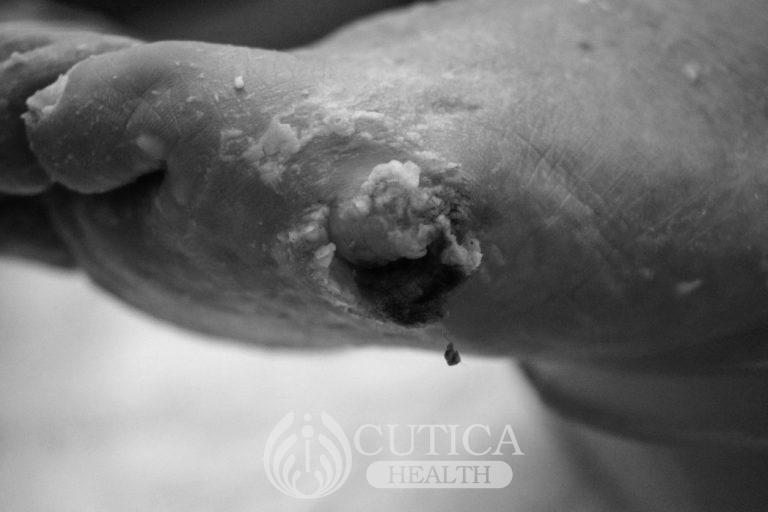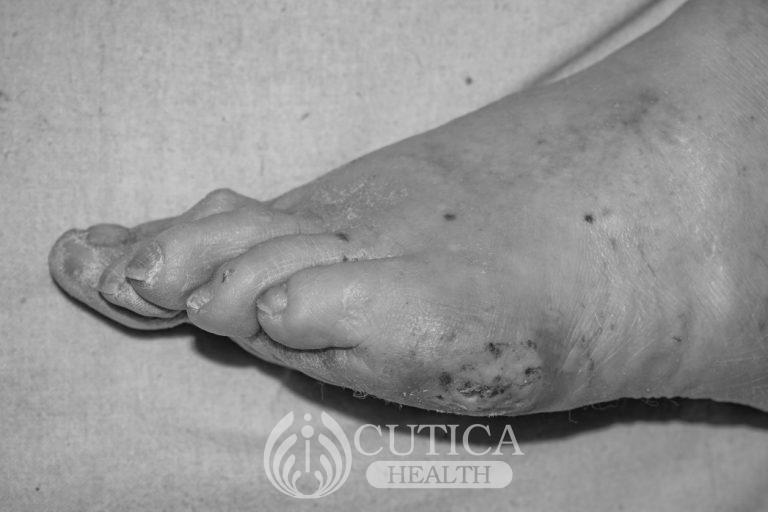
Foot infections and ulcers (or open sores) are two of the most feared complications of diabetes. Left untreated, they may lead to amputation. Thankfully, they are preventable. If you are diabetic, make sure you take special care of your feet. Sudden redness with pain or an open sore that fails to heal should lead you to contact your health care provider.
Typical Signs & Symptoms
While living with diabetes can be challenging, foot infection adds to the stress as Amani’s case shows:
Amani is a 52-year-old woman with diabetes for the past ten years. She is the breadwinner of a family of 6, after being widowed three years ago. To make ends meet, she hawks farm produce around nearby estates three days a week. She typically wears flat plastic shoes that she describes as comfortable for long walks. Amani barely makes enough money to go for check-ups and get her medication, so she sometimes skips her diabetes medicine. Her foot problem started about a month ago. First, she saw a blister at the edge of her left big toe, but she dismissed it, thinking it would go away on its own. Days passed, and the blister opened into a sore that did not heal. After a few weeks, she noticed yellowish discharge from the affected area. She finally decided to visit the health center because her entire foot became painful and swollen and the drainage from her toe worsened.

Unfortunately, by the time Amani got to the health facility, both medical and surgical interventions were needed to save her foot. Amani’s case is one of the everyday stories of persons with diabetes. She should have contacted her doctor earlier before bacteria got into the open sore.
Here are the things to look out for:
The signs and symptoms depend on the type of diabetic foot infection. Diabetic foot infections can be mild, moderate, or severe.
Mild infection involves the skin and the tissues just under it. The symptoms include painful redness and swelling with warmth but no ulcer or discharge. Such relatively mild foot infection is known as cellulitis. Moderate infection gets deeper into the skin and the tissues under it. An ulcer may be present with discharge or pocket of pus, called abscess. Severe infection involves the entire skin depth and may even go into the bone (called osteomyelitis). Severe infection can cause gangrene when the skin and surrounding tissues die.

A special warning for diabetics is that pain may be absent when there is foot infection, depending on the extent of nerve damage (called peripheral neuropathy) that the person has. Those whose eyesight has been damaged by diabetes are also at risk of being unaware of foot infection until advanced stages.
When to visit a doctor
If you notice painful redness or a wound that does not heal, it is time to contact your doctor. Amani should have visited the doctor earlier. Promptly manage suspicious skin changes to reduce infection risks. This will make life easier for both you and your loved ones – as well as reduce health care costs and improve the overall quality of life.
Risk factors

Well, Amani wore plastic shoes which, to her, were comfortable but predisposed her to blister formation and foot infection. Because she was not taking her medications properly, Amani’s blood sugar was not under control. High blood sugar levels made her prone to nerve damage and poor blood circulation – increasing the risk of diabetic foot infections. Other things that can increase the risk include poor foot care, walking barefoot, prior history of a foot infection, foot deformity (bunion or hammertoe), and obesity.
Treatment
The goal of treatment is to get healing as soon as possible. Your medical doctor will determine what investigations to carry out to manage the diabetic foot infection effectively. Also, depending on the extent of disease or damage, your doctor can involve a podiatrist, vascular surgeon, or orthopedic (bone) surgeon. Thankfully, most diabetic foot infections are effectively managed by medical doctors, clinical officers, and nurses. These health providers are readily available in most health centers. So, no one should delay management of foot infection merely because they cannot access a specialist.
For mild infections, your doctor may give painkillers, oral antibiotics, manage blood sugar levels with medication and counsel you on foot care, while for moderate foot infections, debridement (meaning local surgery to remove dead or dying tissue) and dressing may be needed. However, for severe diabetic foot infections, intravenous antibiotics are likely to be used as well as more extensive surgery.
Prevention
Diabetic foot infections are preventable by avoiding and managing the predisposing factors. Well controlled blood sugar and proper footwear and care are the hallmarks of prevention. Adherence to diabetes medication, regular checks at the doctor’s and lifestyle plus diet modification are important to keep blood sugar well controlled. If diabetes has affected the nerves in your feet, try to examine your feet every night, or ask someone to examine them for you if you also have impaired vision. By being proactive, you can substantially lower the risk of foot infection and other complications of diabetes.
Conclusion

Diabetic foot infections are common; however, they are preventable and manageable. Prevention is the ideal way to deal with diabetic foot infection, but if an infection arises, treat it promptly.
Contributed by Bianca Mwaura, BSC, RCO, DCC












